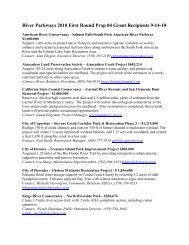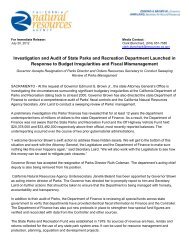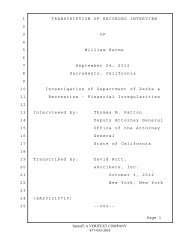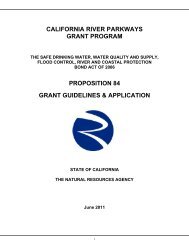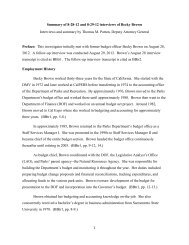California's Ocean Economy - California Resources Agency - State ...
California's Ocean Economy - California Resources Agency - State ...
California's Ocean Economy - California Resources Agency - State ...
You also want an ePaper? Increase the reach of your titles
YUMPU automatically turns print PDFs into web optimized ePapers that Google loves.
NOEP<br />
• Where data for the individual industries are available, users may adjust the sector totals<br />
to suit specific preferences, if desired.<br />
On balance, the strengths of the methodology outweigh the weaknesses. For the most part,<br />
the weaknesses are inherent to either the original data sources used or to the nature of any<br />
taxonomic process or to data availability limitations that cannot easily be overcome. The<br />
NOEP methodology is still under development, and ways must be found to control for both<br />
the upward and downward biases in the data in order to improve the estimates.<br />
A.2 Market and Non-Market Valuation<br />
The ocean, like other environmental assets, may be viewed as a set of natural resources that<br />
provide a stream of valuable services over a period of time (Freeman, 2003). These services<br />
can be direct, like swimming or sunbathing on a beach, boating or recreational fishing. Or<br />
they can be indirect, like ecological preservation or influencing climates. Moreover, these<br />
services may be traded in markets with prices, like overnight camping fees, or fishing<br />
permits. These services can also be available outside traditional markets, like the recreational<br />
value of a day at the beach, or day of recreational fishing. Much of what a beach visitor<br />
values in a “day at a beach” or a surfer values in a “day of surfing” is not bought and sold in<br />
markets, and therefore, the value of these added services is often omitted in traditional<br />
economic valuation/impact studies, or is not directly linked to the natural asset that provides<br />
these services.<br />
The process of determining the economic value of those activities that are not traded in the<br />
market is not the same as calculating the value of something that is traded in the market<br />
place such as purchasing a boat or buying a swim suit. These activities have non-market use<br />
values to those who partake in them, which must be estimated indirectly and somewhat less<br />
precisely than a market activity. Non-market valuation methods have been increasingly used<br />
to estimate that “value “of recreational activities that are not captured by market<br />
transactions, although the methods for determining these values are less precise and still<br />
becoming more sophisticated. Non-market valuation methods can be broadly divided into<br />
two groups: surrogate market techniques and simulated market techniques. Surrogate<br />
market techniques attempt to estimate implicit (substitute) values for environmental goods<br />
and services by means of the price of another good or service that is marketed. These<br />
techniques use actual market prices to value an environmental quality or resource that is not<br />
marketed. The idea behind these methods is that prices for many marketed goods and<br />
services differ across seemingly equal units due to different environmental qualities, scale or<br />
setting, and these price differentials reflect a purchaser’s valuation of the environmental<br />
effects associated with any particular unit. Hedonic Pricing and Travel Cost are the two<br />
most widely used methods under this category. Simulated market techniques are not based<br />
on observed behavior, but on a user’s responses to survey questions, which try to mimic the<br />
actual market. These experimental situations ask users to choose between things, to give<br />
information about the value they place on certain costs or benefits. Contingent Valuation<br />
methods are the most commonly used simulated market techniques.<br />
Estimates of non-market values of ocean-related recreational activities in <strong>California</strong> are<br />
imprecise and subject to a range of biases. The users’ valuation of beaches, recreational<br />
134



